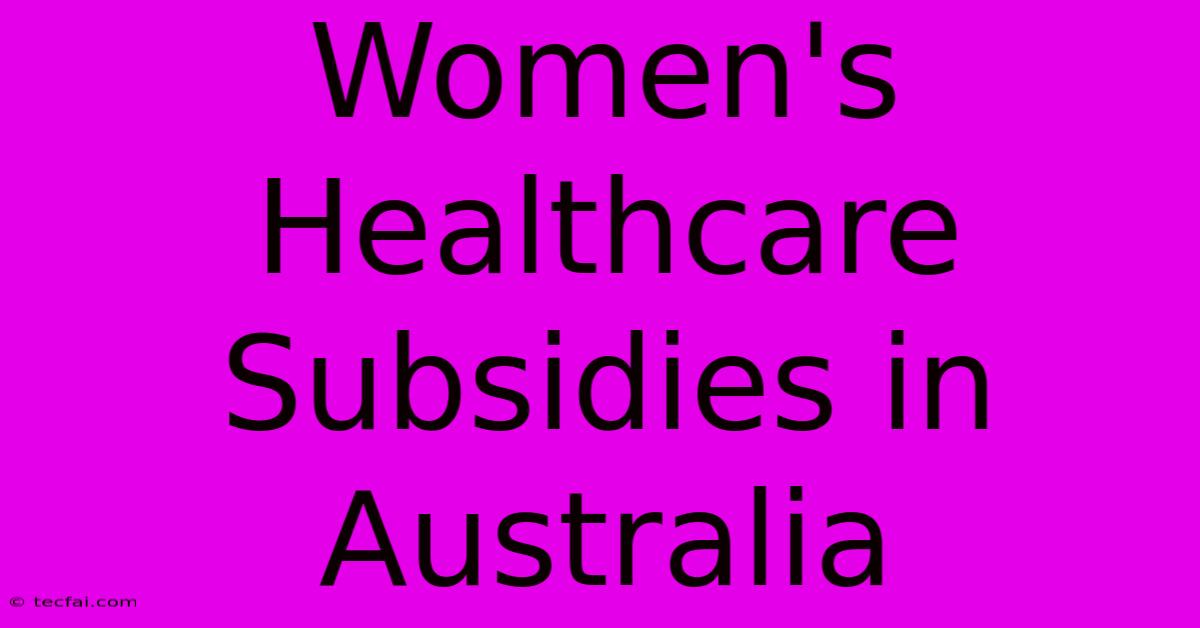Women's Healthcare Subsidies In Australia

Discover more detailed and exciting information on our website. Click the link below to start your adventure: Visit Best Website tecfai.com. Don't miss out!
Table of Contents
Women's Healthcare Subsidies in Australia: A Comprehensive Guide
Access to affordable healthcare is crucial, particularly for women's health needs, which often span reproductive health, preventative care, and chronic conditions. Australia has a system of subsidies designed to make healthcare more accessible, but understanding how these subsidies apply to women's health can be complex. This guide breaks down the key aspects of women's healthcare subsidies in Australia.
Medicare and Women's Health
The cornerstone of Australian healthcare is Medicare, a universal healthcare system providing free or subsidized access to a range of medical services. For women, this means significant assistance with:
- Gynecological consultations: Standard consultations with gynecologists are subsidized under Medicare, reducing the out-of-pocket expense for patients.
- Antenatal and postnatal care: Medicare covers a substantial portion of the costs associated with pregnancy and childbirth, including check-ups, ultrasounds, and hospital stays for uncomplicated births. However, private health insurance may offer additional benefits.
- Pap smears and breast screenings: These crucial preventative health checks are largely subsidized or free under Medicare, encouraging early detection and intervention.
- Family planning services: Access to contraceptives and family planning advice is generally subsidized, although the specifics can vary depending on the provider and the type of service.
Understanding Medicare Rebates
Medicare doesn't cover the entire cost of healthcare. Instead, it provides a rebate – a portion of the fee – which the patient pays the doctor. The remaining amount, the "gap," is the patient's responsibility and can vary greatly depending on the doctor's billing practices. Some doctors bulk-bill, meaning they charge only the Medicare rebate, eliminating the gap.
Beyond Medicare: Other Subsidies and Support
While Medicare forms the foundation, other subsidies and support mechanisms enhance access to women's healthcare:
Pharmaceutical Benefits Scheme (PBS)
The PBS subsidizes the cost of many prescription medications, making essential treatments more affordable for women managing chronic conditions like endometriosis, PCOS, or menopause symptoms. The PBS safety net helps reduce the cost of medications once a certain amount of spending is reached within a calendar year.
National Disability Insurance Scheme (NDIS)
The NDIS provides support for Australians with significant and permanent disabilities. Women with disabilities requiring specific healthcare services may be eligible for funding through the NDIS, covering a range of needs from assistive devices to specialist care.
State and Territory Initiatives
Individual states and territories may offer additional women's health initiatives and subsidies. These programs can vary significantly, so it's essential to check the resources available in your specific location. This could include subsidized mental health services, specialized support programs, or initiatives focusing on specific demographics like Aboriginal and Torres Strait Islander women.
Private Health Insurance and Women's Health
Private health insurance offers a supplementary layer of coverage, providing benefits not covered by Medicare or covering a larger portion of costs than Medicare alone. This can include:
- Faster access to specialists: Private health insurance can reduce wait times for consultations with specialists, crucial for timely diagnoses and treatments.
- Private hospital cover: Choosing private hospital cover offers more choice of hospital and potentially a higher standard of accommodation during pregnancy and other procedures.
- Additional benefits: Some policies offer extras like physiotherapy, which may be beneficial after childbirth or for managing chronic conditions.
Navigating the System: Tips for Accessing Subsidies
- Understand your Medicare card: Ensure your card is current and details are accurate.
- Check with your doctor: Ask your doctor about bulk-billing options and what fees will be involved.
- Inquire about PBS listings: Verify if your prescribed medications are on the PBS list.
- Explore state and territory initiatives: Search your local health department's website for available programs.
- Consider private health insurance: Carefully compare policies to find one that fits your needs and budget.
Accessing affordable and quality women's healthcare is vital. By understanding the layers of subsidies and support available in Australia, women can take control of their health and access the care they need. Remember to always check for updates and changes in regulations, as healthcare policies can evolve over time.

Thank you for visiting our website wich cover about Women's Healthcare Subsidies In Australia. We hope the information provided has been useful to you. Feel free to contact us if you have any questions or need further assistance. See you next time and dont miss to bookmark.
Featured Posts
-
Chiefs Vs Royal Am Begin Xi
Dec 01, 2024
-
Foord Fuels Matildas For Brazil
Dec 01, 2024
-
Canadiens Vs Rangers Game Preview
Dec 01, 2024
-
West Ham Vs Arsenal Begin 11
Dec 01, 2024
-
Barcelona Vs Las Palmas Live La Liga Updates
Dec 01, 2024
